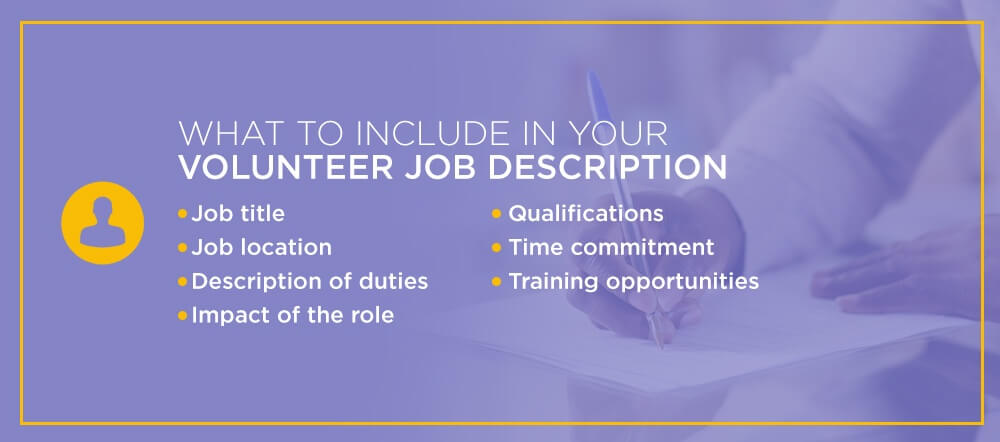If your organization relies on volunteers, you know how essential it is to attract good people. Your volunteers may form the backbone of your programs, performing the day-in and day-out work that allows you to focus on the long-term impact and growth your mission can achieve. You need your volunteers to be compassionate, hardworking, trustworthy, and pleasant to work with.
How do you attract volunteers? You’ll need to write an informative, engaging job description to draw them in. In this guide to writing volunteer position descriptions, we’ll discuss how to write a job description for a volunteer in order to recruit quality candidates.
What to Include in Your Volunteer Job Description
Before you begin writing a volunteer job description, you should know how to define “volunteer.” Volunteers are individuals who freely provide valuable services to nonprofit organizations. Typically, volunteers undergo training and report to a supervisor when fulfilling their duties.
When you’re thinking about how to write a volunteer job description, you’ll need to know what to include. You may even want to look online for a sample of a volunteer job description to help you get started. For example, a volunteer’s responsibilities might include completing tasks assigned to them by their supervisor, supporting the nonprofit’s values, demonstrating a high degree of professionalism, arriving on time, following instructions, and improving the overall workings of the nonprofit.
To be informative and helpful, a good job description will include several different elements like these:
- Job title: The job description should clearly list the title of the role. Your organization may have multiple volunteer roles, and volunteers will need to be certain about which one they’re applying for.
- Job location: The role may take place in your building, or it may be an off-site position in the community. Let your volunteers know precisely where they’d be working.
- Volunteer responsibilities and duties: Spell out what tasks the role would require of potential volunteers. Some volunteers may not realize that a cat-care shift involves more cleaning than snuggling or that a particular support role is largely filing or envelope-stuffing.
- Impact of the role: Let your volunteers know what impact the job will have in the community. Tell them how it supports your mission, helps your clients, or bolsters a particular program.
- Qualifications: Let volunteers know what attainments or characteristics they must have. These may be specific, like particular skills or a certain level of education, or they may be broader requirements, like a cheerful demeanor or the ability to work on their feet for several hours.
- Time commitment: Tell your volunteers how much of their time you’ll ask for. Include the shift lengths and how many hours per month or week they should expect to serve.
- Training opportunities: If your organization provides specialized training, let your volunteers know what that training will look like and when and how they will receive it.
- Work environment: Provide a description of where the work will be and if there are any special tools needed. You might also include whether there are physical requirements too.
- Supervision: Include a brief statement about who the volunteer’s supervisor will be and how often they should meet with them. Including real names helps the volunteer feel more prepared.
- Volunteer perks: While many volunteers don’t get involved for the benefits, it’s nice to include them anyway. For example, you might detail that volunteers will receive a free meal after the event or get a complimentary t-shirt to mark their participation.
- How to apply: Provide a link to the application and directions explaining how to submit the form. It can also be helpful to include contact information for the person responsible for applications.
The Importance of Writing a Compelling Volunteer Job Description
What is the importance of volunteer job descriptions, and why do you need to write an enticing one? Thorough job descriptions provide numerous benefits for the recruitment process, including the following:
1. Providing Adequate Information
In volunteer recruitment, clarity is essential. Volunteers will want to know specific information about the job duties, how much of a commitment it entails, how long the job will last, and what they can expect when they start. Giving your potential volunteers clear information helps you come across as organized and responsible and enables volunteers to make an informed decision about whether this role is right for them.
2. Delineating Requirements
Communicating about requirements with your potential volunteers helps eliminate guesswork and lets them know exactly what you need for the role. Maybe you require your volunteers to be a certain age, have a particular skill set, or adhere to a specific dress code. Letting volunteers know about these stipulations up front can help make sure you get applicants you’re excited about accepting.
3. Answering Potential Questions
It’s common for eager volunteers to have lots of questions. Though you may appreciate their energy and enthusiasm, you may not have time to field the same questions over and over. You can decrease repeat inquiries by putting that essential information into your job description. This is especially true in job descriptions for volunteers in nonprofits, where you may find your resources and time stretched extra thin.
4. Setting Job Expectations
Once you have your volunteers, you’ll need to know they can perform the work to the level you need. Even though your volunteers are unpaid, you’ll likely still be holding them to your organization’s standards of professionalism and performance. Making your standards clear in advance lets your volunteers know what you expect and how they can make a good impression.
5. Elaborating a Benchmark for Success
Similarly, you’ll want your volunteers to know what achievement in the role will look like. Will it be measurable? Are you hoping volunteers will get a certain amount of work done each shift? Or is showing up each day with a positive attitude and a willingness to take direction all you ask for? Letting your prospective recruits know what a strong volunteer looks like will help set them up for success.
6. Communicating a Sense of Your Organization
Potential volunteers want to know what working for you will be like so they can gauge how much they’ll enjoy the experience. Use your job description to convey a genuine sense of your organization’s culture. Maybe your organization is a venerated museum where volunteers will need to be formal and ultra-courteous with visitors. Or maybe it’s a laid-back animal shelter where a day without being smothered in puppy kisses is a day of missed opportunities. Let your volunteers know so they can make an informed decision about committing.
7. Conveying the Benefits of the Work
Volunteers want to make an impact, but they’re probably also hoping to get something out of the experience. Use your job description to illustrate those benefits. Maybe your volunteers will gain particular skills in marketing or fundraising, or maybe they’ll get the fulfillment of working directly with kids to increase childhood literacy. Presenting these benefits in an engaging way can help you gain enthusiastic and passionate volunteers.
8. Illustrating How Volunteers Can Make a Difference
Your job description should delve into the details of the role, and it should give a sense of the bigger picture as well. Maybe your volunteers walk dogs around the yard every day — and they’ll also be providing needed enrichment and stress relief. Or maybe they’ll be chopping ingredients in the kitchen — and they’ll also be helping an overworked mom feed her kids warm food for the first time that week. Showing volunteers their potential impact on the community can help fire them up to get started and put forth their best effort.
9. Ensuring the Right Fit
According to recent surveys by the Corporation for National and Community Service (CNCS), 77.34 million American adults volunteer their time. You need to find the adults who mesh well with your work. A good job description will strike a balance between attracting passionate workers while also providing a realistic depiction of the duties and challenges of the role.
3 Tips For Writing a Volunteer Job Description
In addition to the information listed above, there are a few more things to keep in mind when writing your volunteer job descriptions.
1. Think About the Language in Your Job Description
While you may have all the necessities in your job description, have you paid attention to the language you used when writing? Your language should be motivating and encouraging so applicants have a desire to help you with the work. It’s common for volunteer job descriptions to seem controlling — like volunteers shouldn’t bring their own experience, talents and ideas to the job. Build trust with the candidate and demonstrate that you value what each volunteer can bring to the role.
2. Share Your Mission
While it doesn’t need to be your entire mission statement and set of values, you should provide a brief statement explaining what your organization’s mission is. Providing information about your mission allows volunteers to quickly determine whether it’s something their beliefs align with.
3. Review and Update Job Descriptions Yearly
As your organization grows and changes, so will your volunteer needs. An annual review of your volunteer job descriptions will ensure you’re finding volunteers that fulfill your updated needs. Revise your descriptions to reflect any changes in your needs and ensure the most up-to-date version is live on the application.
Job Description Template
While each volunteer job description will vary depending on your organization’s needs, consider starting with a template like this one:
- Job title: Volunteer public speaker.
- Job location: Public venues like schools or libraries and private venues like corporate meetings.
- Description of duties: Give virtual and in-person presentations that explain our programs and the outcomes we can produce, respond to speaking requests, give out promotional materials at your events, report the number of attendees and any audience feedback.
- Impact of the role: You’ll share our organization, our mission, and our work with those who may be unfamiliar with it. This helps us broaden our reach and connect with more people.
- Qualifications: Experience speaking to various-sized groups of people, basic knowledge of presentation software, punctuality, willingness to learn and the ability to inspire and inform.
- Time commitment: Present on an as-needed basis, as your schedule allows. At least two presentations are required per year.
- Training opportunities: We provide training orientation materials to ensure you have the proper knowledge of our organization. We also require speakers to give two trial presentations before speaking to crowds.
- Supervision: You will report to the volunteer coordinator, who will be responsible for your training and approval to present.
- Volunteer perks: Volunteers for this position receive free access to presentation software and the necessary electronics.
- How to apply: Fill out the application at this link and send a copy of your resume to our applications coordinator at appscoodinator@organization.org
Partner With Volgistics for an Appealing Volunteer Management Platform
Creating job descriptions that volunteers will love helps you attract engaged, passionate workers who understand the role and your mission. Once you’ve drawn those volunteers in, you need an equally appealing and user-friendly way to manage them.
Consider making Volgistics your trusted partner for a volunteer management platform that allows your volunteers to sign in and out for their shifts, set their schedules, and track their hours. With Volgistics’ Opportunity Directory and online volunteer application forms, you can easily showcase volunteer assignment descriptions on your website and collect information from prospective volunteers. You can also use it for creating comprehensive volunteer reports, and texting and emailing your volunteers. It makes the logistics of volunteer roles easy to handle so they can get right to doing meaningful work — and so can you.
Contact us today to learn more.




